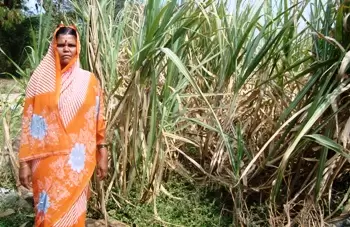An EU-funded project helps farmers save water and reap more from sugarcane crop
18-August-2011
Vol 2 | Issue 33
Laxmibai Shelke was skeptical when she heard of some farmers experimenting with new methods of cultivation to boost their sugarcane production. But when yet another harvest saw a poor yield from her 10-acre land, the 45-year-old illiterate woman, hailing from Bhidhanora village in Maharashtra, knew it was time to discard conventional farming methods followed unquestioningly for generations.
With some trepidation, this farmer decided to plant her stem cuttings in December, a full month later than what she normally did. She also increased the spacing between each cutting from a single foot to four feet.
 |
|
Better yield: Women farmers who adopted best management practices in their sugarcane fields have reported an increase of up to 50 percent in yield (Photo: WFS)
|
Another bold step was to switch from the traditional “dry” method in which the cuttings are planted in dry soil (as against wet soil) followed by irrigation. Finally, in what she describes as the most daring decision she’d ever taken, Laxmibai changed her irrigation technique by replacing the traditional “zig-zag”, or serpentine furrows, with straight ones.
The results were magical. Not only did she get a far superior yield, her water consumption went down drastically. “Earlier I used to get between 35-40 tonnes of cane per hectare, but this year by using the new methods, my production rose to about 60 tonnes per hectare,” says Laxmibai happily. “By adopting the furrow system of irrigation, I have also reduced my water usage by 50 per cent!” she adds.
Fellow sugarcane farmer Kantabai Chavan, 45, has a similar success story to narrate. “During the period October 2010 to March 2011, I produced 60 tonnes of cane per hectare on my two-acre plot by using new methods of cultivation,” she informs. “With conventional farming methods, my yield never exceeded 40 tonnes per acre. Also, the straight furrow technique has reduced my water consumption by more than 30 per cent,” observes Kantabai.
Laxmibai and Kantabai represent a new crop of farmers who are creating waves in sugarcane cultivation in Aurangabad district of Maharashtra, the second largest sugar-producing state in India after Uttar Pradesh.
With assistance from an innovative project which focuses on best management practices (BMP), these farmers are enhancing the quality of their lives by improving their yields and profits. The European Union (EU)-funded project – ‘Reducing the Impact of Water-intensive and Polluting Crops: Securing sustainable sources of freshwater to support the livelihoods of poor communities in the Godavari Basin’, was launched in Aurangabad in 2007. So far, about 700 farmers including women in 12 villages of the district are benefiting from the project that is being facilitated by the Worldwide Fund for Nature – India (WWF – India).
Under the programme, farmers’ groups have been set up to train people from selected trial plots. “These farmers will then pass on their experiences to other community members,” says Sumit Roy, WWF – India’s Project Manager for Freshwater & Wetlands Programme.
“For most of us, the sowing time was anywhere between November 25 to February 26,” remembers Laxmibai. “Now we know that the best time for sowing is from December 3 to January 12. Also, I have observed in my field that by keeping a distance of four feet between each sapling, more air is given to the crop, which helps to improve its quality.” - Women's Feature Service















